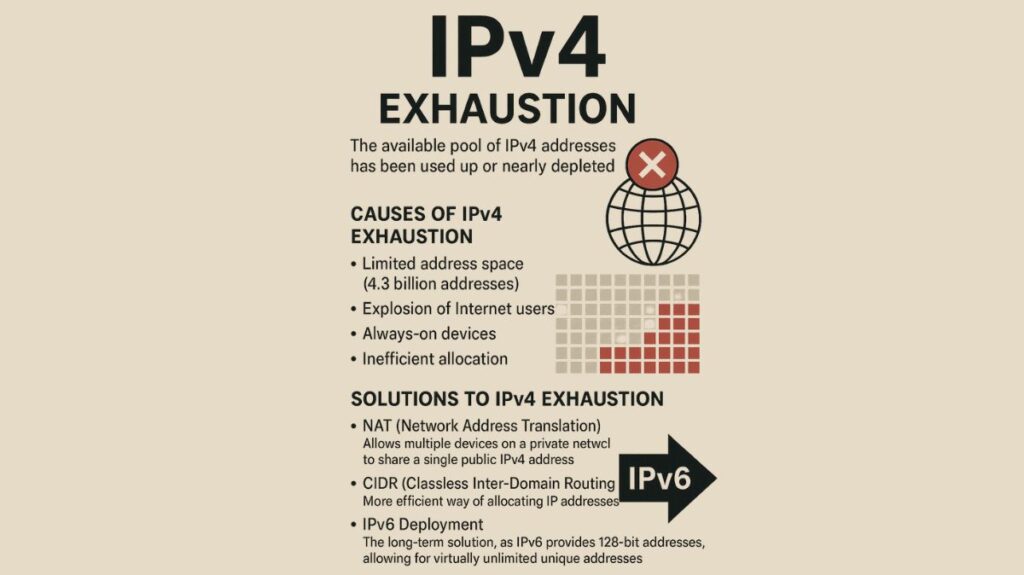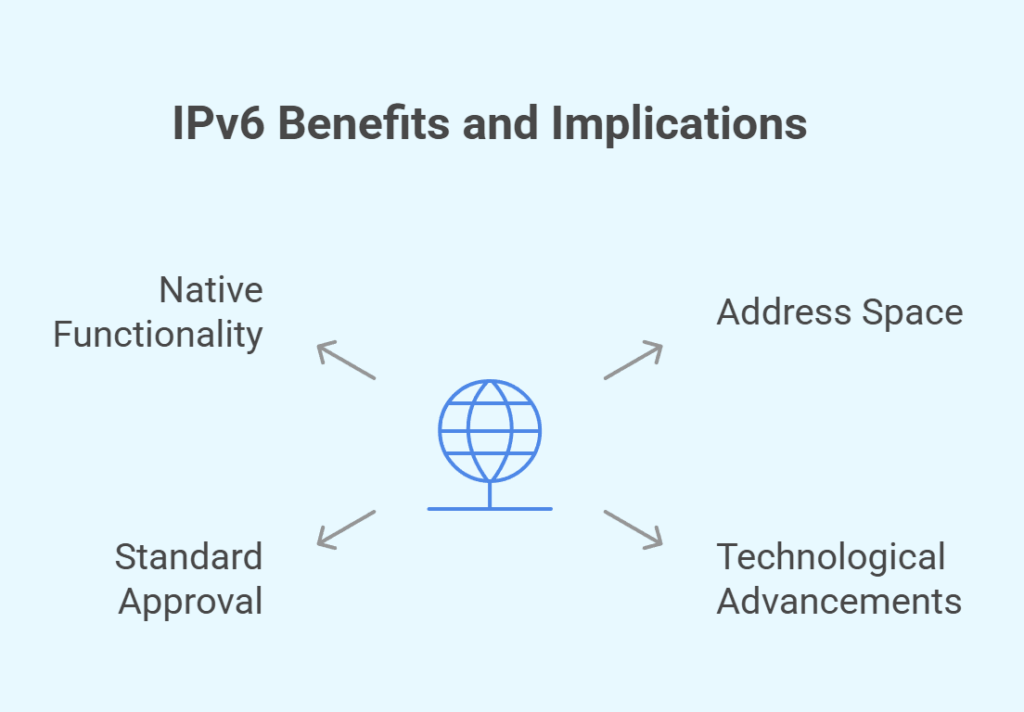Ipv4 address exhaustion
The term “IPv4 exhaustion” describes the point at which there is no more public IPv4 addresses available worldwide, making it impossible to assign fresh, distinct addresses to businesses and Internet-connected devices. It is the exhaustion of unallocated IPv4 addresses, which provide as distinct identification for internet-connected devices. This issue emerged as a result of the 32-bit IPv4 address pool being exhausted or almost exhausted.

Inherent Limitation of IPv4
In 1980, IPv4 was standardized. Because of the 32-bit address space used in its architecture, roughly 4.3 billion unique addresses (2^32) are possible. However, the number of usable addresses is far smaller (e.g., only 3.7 billion according to one source) because of multiple reservations and the original classful addressing method. The Internet and business networks grew quickly and widely, but this small address pool was not enough. To give each Internet device or service a distinct, publicly routable address, the IPv4 addressing scheme is insufficient.
Also Read About What Is A Firewall? History Of Firewalls, Types Of Firewalls
Historical Timeline of Depletion
- The early 1990s saw the emergence of concerns around IPv4 address exhaustion, with projections indicating that it would occur by the mid-1990s.
- In early 2011, the five Regional Internet Registries (RIRs) received the last five /8 address blocks from the Internet Assigned Numbers Authority (IANA), which oversees the global IP address space and distributes global IPv4 address blocks. IANA was left with no more public IPv4 addresses to distribute after this. On January 31, 2011, this top-level fatigue took place.
- IPv4 address allocation within particular geographic regions is overseen by Regional Internet Registries (RIRs), which include APNIC, RIPE NCC, and ARIN. RIRs still needed to distribute addresses within their regions after IANA’s pool ran out in 2011, however these regional pools have also run out of space over time.
- In April 2011, Asia-Pacific (APNIC) was the first RIR to use up its whole pool.
- RIPE NCC (Europe, Middle East, Central Asia) officially ran out of its last reserves on November 25, 2019, after reaching exhaustion in September 2012.
- In June 2014, the Latin America and the Caribbean (LACNIC) pool was depleted.
- On September 24, 2015, ARIN (North America) declared that it has run out of IPv4 addresses before the end of 2015.
- AFRINIC (Africa) initiated its IPv4 exhaustion phase 1 on March 31, 2017, and phase 2 on January 13, 2020, after reaching its last stages of allocation. The majority of RIRs had utilized up all of their IPv4 address space as of 2019, and strategies were in place to recover and redistribute any unused numbers. As a result, new businesses looking to connect to the Internet have no choice except to adopt IPv6 because public addresses are no longer available.
Causes and Aggravating Factors of Exhaustion
Limited Address Space: As previously indicated, only roughly 4.3 billion addresses are available in the 32-bit system.
Growth in Internet Devices and Users: The need for unique IP addresses has grown dramatically as a result of the Internet’s quick and extensive expansion as well as the rise in linked devices, such as computers, smartphones, IoT devices (smart TVs, gadgets), and cloud services.
Always-On Devices: As a result of the transition from dial-up to always-on broadband connections, routers and modems were rarely turned off, which allowed ISPs to continuously acquire addresses.
Inefficient Allocation: Because smaller units were insufficient for the demands of large corporations or institutions, the early distribution of IPv4 blocks was not optimized, and they frequently received considerably more addresses than they required (e.g., Class A blocks with 16 million addresses). Underutilized blocks and waste were the results of this.
Short-Term Solutions to Delay Exhaustion (Workarounds)
To prolong the life of IPv4, the Internet Engineering Task Force, or IETF, created and pushed a number of temporary fixes:
Network Address Translation (NAT):
When interacting with the Internet, NAT enables several private IP addresses inside an internal network to share one or a few public IPv4 addresses. A common type of NAT that allows thousands of internal hosts to use a single public IPv4 address by distinguishing connections based on port numbers is called Port Address Translation (PAT), sometimes referred to as NAT overload. The main explanation for why IPv4 addresses did not run out much sooner is PAT. However, programs that need direct incoming connections may encounter difficulties due to NAT, which disrupts genuine end-to-end connectivity.
Private Addressing (RFC 1918)
In private networks that do not require direct public Internet connectivity, certain IPv4 address ranges (10.0.0.0/8, 172.16.0.0/12, and 192.168.0.0/16) were set aside for use. By using these numbers internally, frequently with NAT, the need for public IPv4 addresses was greatly decreased.
Also Read About What A Network Is And What Are Benefits Of Networking
Classless Inter-Domain Routing (CIDR)
CIDR, which was defined in RFC 4632, reduced IP address waste and enabled route aggregation to make Internet routing tables manageable by allowing ISPs to assign public IPv4 addresses in smaller, more efficient blocks (any prefix length, not only classful bounds). By making routing tables on internet routers smaller, CIDR also made it possible to use IP address space more effectively.
Carrier-Grade NAT (CGNAT)
ISPs can serve more customers with fewer publicly routable IPv4 addresses to Carrier-Grade NAT (CGNAT), an ISP-level NAT that permits multiple devices to share a single IP address.
Subnetting
Subnetting is the process of breaking up a larger network into smaller subnetworks in order to improve IP address management, decrease network congestion, and maximize address space usage.
Consequences and Impacts of Exhaustion
Challenge in Connecting New gadgets:
- Businesses, organisations, and new gadgets find it challenging to connect to the Internet due to the scarcity of publicly routable addresses.
- Higher IP Address Acquisition Costs: Due to the scarcity, IPv4 addresses are now more expensive, especially for smaller businesses. There is now a secondary market for IPv4 addresses where businesses can sell their unused addresses.
- Less Innovation and Growth: The technology industry has suffered from IPv4 exhaustion, which has restricted innovation and growth. Due to limitations and the expense of acquiring more IP addresses, startups may find it difficult to break into the market, and established businesses may have challenges when attempting to introduce new products or increase their online presence.
IPv6: The Long-Term Solution

- IP version 6 (IPv6) is the best long-term remedy for IPv4 address exhaustion.
- IPv6 addresses have a huge address space (about 3.4 x 10^38 addresses) because they are 128 bits long. For years, the issue of address depletion is resolved by this enormous address space.
- After recognising the issue long ago, the Internet Engineering Task Force (IETF) began developing IPv6, which was formally approved as an Internet Standard on July 14, 2017, after first being a draft standard in 1986.
- Making the switch to IPv6 is essential for guaranteeing that all Internet devices and services have enough unique addresses, as well as for facilitating new technological advancements like 5G networks and the Internet of Things. The majority of recently installed equipment has native IPv6 functionality built into the operating system.
Coexistence and Transition
- Because IPv4 and IPv6 packets have different headers, they are not inherently compatible.
- Several transition strategies are used, including tunnelling (encapsulating IPv6 packets within IPv4 packets for transmission across IPv4 networks, or vice versa) and dual-stacking (running both IPv4 and IPv6 simultaneously on devices and networks). There are also IPv4-mapped IPv6 addresses for particular transition situations.
- There are several obstacles to overcome while making the switch to IPv6, including the requirement to update both hardware and software, high expenses, incompatibilities with older systems, and a lack of knowledge or qualified experts. Nonetheless, the use of IPv6 is growing steadily.
Also Read About Advantages And Disadvantages Of TCP IP Model & Its Functions
